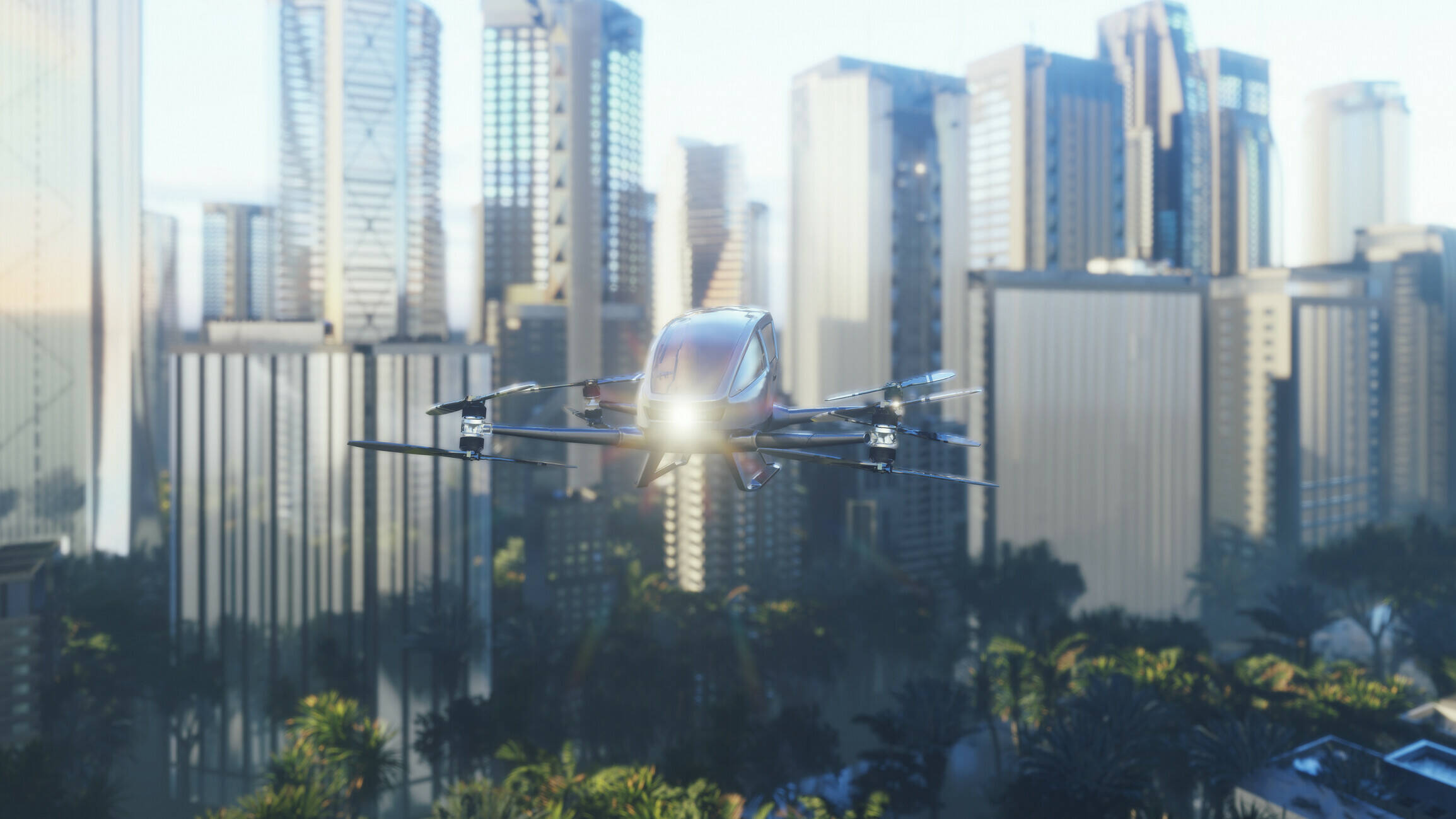


Rob Weaver, Urban ATM Global Business Development Lead, Eve Air Mobility


Energy reserve
Vertiports
eVTOLs will always fully charge overnight and likely take what charge they can between journeys. Both the Federal Aviation Administration (FAA) and the European Aviation Safety Agency (EASA) are working on reserve energy requirements, just as an aircraft takes on reserve fuel.
“This will be an important development as it will dictate how we operate,” suggests Weaver. “You might need to have an alternative landing location with a charging point. Also, if we need bigger batteries, that means more weight. So, there is a lot of fine-tuning to be done.”
All this detailed work takes time, but Weaver is convinced the next 18 months or so will see the work completed.
VECTOR has attracted interest from air navigation service providers (ANSP) throughout the world. The company is also collaborating with UK ANSP, NATS, on a global basis. Although the FAA has indicated that it will leave urban air mobility to private providers, in many places it is expected ANSPs will be an integral component in service provision.
By 2050, Weaver expects a huge diversity of airspace users offering a full range of services and all types of aircraft. There will still be traditional civil aviation users, but the skies will also be replete with autonomous systems using different energy sources and with unique performance models.
“Airspace also will become prized and extremely valuable,” he notes. “The radio communication spectrum will be crucial to enabling diversity and demand, and this is another aspect that must be sorted out quickly.”
As for air traffic controllers, they will be over the loop rather than in it – in other words, they will supervise a predominantly autonomous system.
“Everything we are working on at Eve is completely agnostic, so we are happy to work with all partners,” Weaver concludes. “Urban air mobility is an emerging market and there is a massive opportunity for fast movers with a flexible outlook.”
VECTOR is more complicated in that it necessarily interacts with all other elements in the ATM ecosystem, including vertiports – airports for eVTOLs.
Eve anticipates high utilisation of each of its aircraft with up to 10 flights a day. And depending on demand and the scope of operations in a particular urban area that could lead to a dense, complex network.
“We’re talking about many to many relationships as an urban air operation involves a lot of players,” says Weaver.
He expects most flights will operate under visual flight rules for a few years yet but, going forward, accepts that a good urban ATM solution must consider integration with drones, 4D flow management, de-confliction and separation standards and the performance characteristics of the continually evolving airspace users.
But it is vertiports that could prove a bigger challenge. There are a number of vertiport companies in the world, but satisfying the conditions for this essential piece of infrastructure won’t be easy. Aside from finding an appropriate parcel of land in a populated area, there is also the question of energy provision.
“At a vertiport, air taxis will need to charge, so it will be a challenge to manage their gates or landing pads,” says Weaver. “There will be nowhere else for an eVTOL to land and the battery is finite. But that is also why utilisation is so important. Vertiports will be expensive to build, and we must make them financially viable.”
Weaver is confident that vertiports will become common in the medium term although their characteristics will vary. Some will be larger, public facilities that also accommodate helicopters and drones while others will be private, perhaps on the top of buildings, and exclusive to passenger-carrying air taxis.
Going autonomous
Eve Air Mobility is a spin-out from Embraer X – the innovation arm of Embraer. The potential shown was such that the company is now listed on the New York Stock Exchange although Embraer retains a significant interest.
The company offers two products:
An electric vertical take-off and landing (eVTOL) aircraft that will be ready for entry into service in 2026. By the end of April 2024, 29 customers had signed up.
An air traffic management system, known as VECTOR, that will be demonstrated in 2025.
“The eVTOL will have a range of about 100km,” explains Weaver. “That’s ideal for getting you, for example, from the new Western Sydney Airport to downtown Sydney, about 40km away. It will have a pilot and four passengers in its initial design but within a couple of decades we would expect it to be fully autonomous and carry six passengers.”
Rob Weaver, Urban ATM Global Business Development Lead, Eve Air Mobility, says first movers in supplying an urban air traffic management solution will gain a significant advantage as the sector is set to advance rapidly.
“Urban air mobility will save time and emissions,” he says. “It is a solution that can truly deliver on zero emissions and provide benefits for all partners, including the end customer.”
Urban air mobility is set to transform the skies around cities. Connecting passengers quickly and efficiently from downtown or suburban locations to airports, these air taxis will integrate with both Air Traffic Management (ATM) and U-Space/Unmanned Aircraft System Traffic Management (UTM). Prototypes are flying and regulations forming.







Rob Weaver, Urban ATM Global Business Development Lead, Eve Air Mobility


Vertiports
VECTOR is more complicated in that it necessarily interacts with all other elements in the ATM ecosystem, including vertiports – airports for eVTOLs.
Eve anticipates high utilisation of each of its aircraft with up to 10 flights a day. And depending on demand and the scope of operations in a particular urban area that could lead to a dense, complex network.
“We’re talking about many to many relationships as an urban air operation involves a lot of players,” says Weaver.
He expects most flights will operate under visual flight rules for a few years yet but, going forward, accepts that a good urban ATM solution must consider integration with drones, 4D flow management, de-confliction and separation standards and the performance characteristics of the continually evolving airspace users.
But it is vertiports that could prove a bigger challenge. There are a number of vertiport companies in the world, but satisfying the conditions for this essential piece of infrastructure won’t be easy. Aside from finding an appropriate parcel of land in a populated area, there is also the question of energy provision.
“At a vertiport, air taxis will need to charge, so it will be a challenge to manage their gates or landing pads,” says Weaver. “There will be nowhere else for an eVTOL to land and the battery is finite. But that is also why utilisation is so important. Vertiports will be expensive to build, and we must make them financially viable.”
Weaver is confident that vertiports will become common in the medium term although their characteristics will vary. Some will be larger, public facilities that also accommodate helicopters and drones while others will be private, perhaps on the top of buildings, and exclusive to passenger-carrying air taxis.
Rob Weaver, Urban ATM Global Business Development Lead, Eve Air Mobility, says first movers in supplying an urban air traffic management solution will gain a significant advantage as the sector is set to advance rapidly.
“Urban air mobility will save time and emissions,” he says. “It is a solution that can truly deliver on zero emissions and provide benefits for all partners, including the end customer.”
Urban air mobility is set to transform the skies around cities. Connecting passengers quickly and efficiently from downtown or suburban locations to airports, these air taxis will integrate with both Air Traffic Management (ATM) and U-Space/Unmanned Aircraft System Traffic Management (UTM). Prototypes are flying and regulations forming.



eVTOLs will always fully charge overnight and likely take what charge they can between journeys. Both the Federal Aviation Administration (FAA) and the European Aviation Safety Agency (EASA) are working on reserve energy requirements, just as an aircraft takes on reserve fuel.
“This will be an important development as it will dictate how we operate,” suggests Weaver. “You might need to have an alternative landing location with a charging point. Also, if we need bigger batteries, that means more weight. So, there is a lot of fine-tuning to be done.”
All this detailed work takes time, but Weaver is convinced the next 18 months or so will see the work completed.
VECTOR has attracted interest from air navigation service providers (ANSP) throughout the world. The company is also collaborating with UK ANSP, NATS, on a global basis. Although the FAA has indicated that it will leave urban air mobility to private providers, in many places it is expected ANSPs will be an integral component in service provision.
By 2050, Weaver expects a huge diversity of airspace users offering a full range of services and all types of aircraft. There will still be traditional civil aviation users, but the skies will also be replete with autonomous systems using different energy sources and with unique performance models.
“Airspace also will become prized and extremely valuable,” he notes. “The radio communication spectrum will be crucial to enabling diversity and demand, and this is another aspect that must be sorted out quickly.”
As for air traffic controllers, they will be over the loop rather than in it – in other words, they will supervise a predominantly autonomous system.
“Everything we are working on at Eve is completely agnostic, so we are happy to work with all partners,” Weaver concludes. “Urban air mobility is an emerging market and there is a massive opportunity for fast movers with a flexible outlook.”
Energy reserve
Eve Air Mobility is a spin-out from Embraer X – the innovation arm of Embraer. The potential shown was such that the company is now listed on the New York Stock Exchange although Embraer retains a significant interest.
The company offers two products:
An electric vertical take-off and landing (eVTOL) aircraft that will be ready for entry into service in 2026. By the end of April 2024, 29 customers had signed up.
An air traffic management system, known as VECTOR, that will be demonstrated in 2025.
“The eVTOL will have a range of about 100km,” explains Weaver. “That’s ideal for getting you, for example, from the new Western Sydney Airport to downtown Sydney, about 40km away. It will have a pilot and four passengers in its initial design but within a couple of decades we would expect it to be fully autonomous and carry six passengers.”
Going autonomous